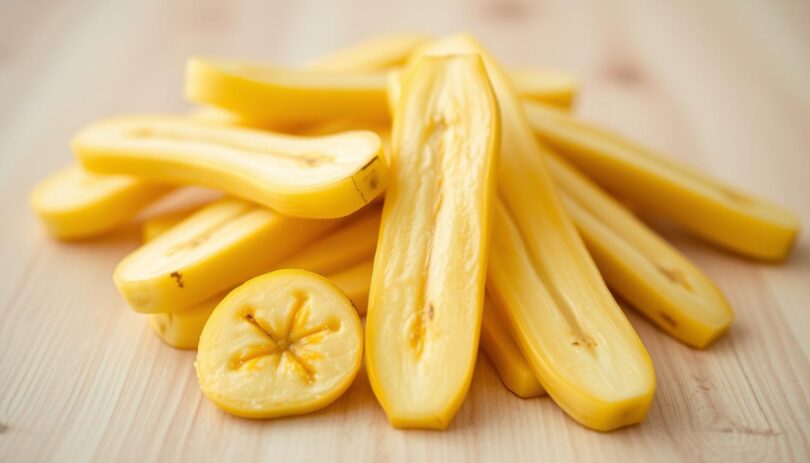What if a common kitchen staple could offer surprising benefits for your pet? While many owners stick to traditional treats, plantains present an intriguing option. This starchy tropical fruit, often mistaken for bananas, has sparked curiosity among pet parents seeking nutritious snack alternatives.
Cooked plantains provide dietary fiber and essential nutrients like potassium and vitamin A. Veterinary professionals confirm they’re safe when prepared properly—always peeled, never raw, and served in bite-sized portions. Moderation remains key to prevent stomach upset or choking risks.
This guide combines insights from animal nutritionists and trusted sources to help you make informed choices. You’ll discover how to transform this versatile fruit into occasional rewards while prioritizing safety. From steaming techniques to portion guidelines, every detail matters for your companion’s wellbeing.
Understanding proper preparation methods turns potential risks into opportunities for variety. Let’s explore how this fiber-rich food can complement balanced diets without replacing core meals. Ready to learn the dos and don’ts of sharing plantains with your four-legged family member?
Overview of Plantains and Their Role in Canine Diets
When diversifying your companion’s meals, certain fruits offer more than just variety. Plantains, often confused with bananas, share a similar shape but differ in texture and culinary use. Unlike their sweeter cousins, these starchy staples remain firm when raw and require cooking to soften. This makes them versatile for human dishes but necessitates preparation adjustments for pets.
Rich in dietary fiber, this tropical food supports digestive regularity and gut health. It also provides potassium for muscle function and vitamin A for vision. Veterinary nutritionists highlight these advantages but emphasize portion control. Overfeeding may lead to temporary stomach discomfort despite the fruit’s nutritional value.
Properly cooked plantains become digestible and non-toxic for animals. Steaming or boiling removes natural toughness while preserving nutrients. Experts recommend treating them as occasional supplements rather than meal replacements. Their role complements balanced diets without displacing protein-rich staples.
Moderation remains critical. Small, unseasoned portions prevent choking risks and calorie overload. Always consult a veterinarian before introducing new items, especially for pets with food sensitivities. When served thoughtfully, this fiber-packed addition can enhance overall wellness without compromising safety.
Nutritional Benefits of Plantains for Dogs
Pet nutrition science reveals surprising allies in everyday foods. This tropical superfood delivers three key advantages: blood sugar stability, digestive support, and immune reinforcement through essential micronutrients.
Dietary Fiber and Blood Sugar Management
The fiber content acts as a natural regulator. Soluble fibers slow glucose absorption, helping maintain steady energy levels. This proves particularly useful for active pets needing sustained vitality.
Proper fiber intake prevents common digestive issues. It adds bulk to stool while absorbing excess water, addressing both diarrhea and constipation. Moderation remains crucial to avoid gastrointestinal upset.
Vitamins, Minerals, and Antioxidants
This food packs vitamin A for eye health and B6 for nerve function. Potassium supports heart rhythms, while magnesium aids muscle recovery after playtime. Antioxidants combat free radicals linked to aging.
Compared to apples or blueberries, plantains offer higher resistant starch. This prebiotic feeds beneficial gut bacteria when cooked properly. Always consult your vet before introducing new items to your companion’s diet.
When prepared correctly and fed in appropriate portions, these nutrients work synergistically. They strengthen defenses against environmental stressors while promoting overall wellness. Balanced nutrition ensures treats complement rather than replace complete meals.
Can Dogs Eat Plantains Safely?
Safety hinges on preparation and portion control. While cooked plantains aren’t toxic, improper handling or excessive quantities can lead to problems. Start by peeling and cooking them thoroughly—raw versions pose digestion challenges and choking risks.
Understanding Serving Sizes and Moderation
Portions should match your pet’s size. For smaller companions, a teaspoon-sized piece suffices. Larger animals might handle a tablespoon. These amounts deliver dietary fiber benefits without overwhelming their system.
Overfeeding disrupts blood sugar balance and causes stomach upset. Introduce cooked plantains gradually—once weekly—to monitor reactions. Always skip seasonings, oils, or sugary additives.
When to Consult Your Veterinarian
Reach out to your vet if your companion has diabetes or food sensitivities. Sudden changes in appetite, energy, or stool consistency after trying new foods warrant professional advice. Discuss how plantains fit into existing meal plans.
Pets with chronic conditions may need tailored guidance. Experts can assess whether the health benefits align with specific dietary needs. This step ensures safety while exploring nutritious additions.
Cooking and Preparing Plantains for Your Dog
Transforming this tropical fruit into safe snacks requires careful preparation. Raw versions contain tough fibers that challenge digestion and may cause intestinal blockages. Cooking softens the texture while enhancing nutrient absorption.
Optimal Techniques for Nutrient Preservation
Boiling retains potassium and vitamin C while eliminating hardness. Steam cooking preserves more water-soluble nutrients compared to other methods. Grilling creates a chewier texture but requires monitoring to prevent charring.
Start by removing the thick peel and discarding any fibrous strands. Slice the flesh into dime-sized pieces for small breeds or quarter-inch cubes for larger animals. Avoid oils, butter, or seasoning—these additives counteract health benefits.
Excess salt strains kidneys, while added sugar disrupts metabolic balance. Plain cooked portions maintain the fruit’s natural advantages as a low-calorie reward. Experts suggest cooling servings to room temperature before offering them.
Observe your companion’s response during initial trials. Loose stools or reluctance to eat may indicate sensitivity. Adjust portion sizes based on weight and activity level, keeping treats under 10% of daily calories.
Potential Health Risks and Precautions
While nutritious additions can enhance a pet’s diet, even safe foods require careful handling. Certain preparation methods and overfeeding may lead to avoidable health complications. Understanding these risks helps owners make informed decisions that prioritize safety.
Choking Hazards and Digestive Sensitivities
Raw versions of this tropical food present immediate dangers. Their tough texture can obstruct airways, especially in smaller animals. Fried foods coated in oil or spices often trigger inflammation and gastrointestinal distress.
Overconsumption frequently results in diarrhea or vomiting. These symptoms indicate the body’s struggle to process excess starch. Chronic inflammation may develop if pets regularly consume seasoned dishes meant for human diets.
Portion control prevents most problems. Start with pea-sized pieces for tiny breeds and adjust based on body weight. Watch for signs like lethargy or changes in stool consistency, which suggest sensitivity.
Avoid sharing plantain chips or commercial products containing additives. These often include harmful ingredients like garlic powder or excess salt. Stick to plain, cooked preparations to minimize risks.
If digestive problems persist after adjusting portions, consult a veterinarian. They can assess whether underlying conditions require dietary modifications. Proactive monitoring ensures new foods complement rather than disrupt nutritional balance.
Exploring the Benefits of Plantain Leaves for Dogs
Nature often provides unexpected solutions for pet care challenges. Beyond the fruit itself, plantain leaves offer unique advantages for skin health. Herbalists and veterinarians recognize their value in addressing minor injuries when used correctly.
Topical Uses for Minor Wounds and Irritations
Fresh leaves work as a natural first-aid option for scrapes or insect bites. Crushing them releases juices containing allantoin, a compound that speeds tissue repair. Create a poultice by mashing clean leaves and applying directly to affected areas for 10-15 minutes.
This method draws out debris while soothing inflamed skin. Studies show the leaves’ high antioxidant content neutralizes free radicals, reducing recovery time. Always rinse the area with water first and monitor for allergic reactions.
Herbal Antibacterial and Anti-inflammatory Properties
Research confirms plantain leaves contain natural germ-fighting agents like aucubin. These compounds prevent infection while calming redness and swelling. Minerals like zinc and magnesium further support skin regeneration by improving blood flow to damaged tissues.
For best results:
• Harvest leaves from chemical-free areas
• Wash thoroughly before use
• Reapply treatments 2-3 times daily until healing occurs
Traditional herbal practices align with modern science here. Many pet owners report faster wound closure when using this approach alongside veterinary care. Always consult your vet before trying new remedies, especially for deep cuts or persistent issues.
Herbal Perspectives and Traditional Uses of Plantain in Canine Health
For centuries, natural healers have harnessed plantain’s versatility beyond its role as a tropical fruit. Historical records show herbalists used both leaves and flesh to address digestive upset, skin irritations, and immune support. Modern research confirms these practices hold value for pets when applied thoughtfully.
Traditional remedies often incorporated plantain to soothe stomach discomfort. Its high fiber content regulates digestion while antioxidants combat inflammation linked to chronic disease. Studies reveal vitamin A and C levels in cooked preparations support eye health and cellular repair.
Herbalists historically combined this food with other fruits to create nutrient-rich tonics. Maintaining balanced vitamin levels through whole foods remains a cornerstone of holistic pet care. Contemporary veterinarians acknowledge these methods when paired with evidence-based nutrition plans.
Practical applications include:
• Steeping dried leaves for gentle digestive teas
• Mixing mashed flesh into meals to ease occasional stomach upset
• Using topical extracts for minor abrasions
Always consult your vet before trying traditional approaches, especially for pets with existing health conditions. When used responsibly, plantain’s historical benefits align with modern wellness goals—providing natural support without replacing medical treatments.
Integrating Plantains into a Balanced Canine Diet
Introducing new ingredients requires thoughtful planning to maintain nutritional harmony. Start with pea-sized portions once weekly, observing reactions before increasing frequency. This gradual approach helps sensitive stomachs adapt without disruption.
Smart Strategies for Dietary Transitions
Base serving sizes on your companion’s current weight. Smaller pets thrive with teaspoon amounts, while larger breeds may handle tablespoon quantities. Always subtract treat calories from daily meals to prevent overfeeding.
Mix steamed cubes directly into regular meals instead of offering separate snacks. This method maintains familiar textures while adding variety. Avoid fried preparations or salted versions—opt for plain cooking to preserve health benefits.
Compare starch content between plantains and bananas when planning treats. While both offer potassium, the former contains more complex carbohydrates. For pets needing low-sugar options, papaya offers similar benefits with fewer calories.
Track energy levels and stool consistency for three days after initial servings. Adjust amounts if soft stools occur, reducing by half until digestion stabilizes. This careful monitoring ensures dietary changes support overall wellness rather than causing stress.
Remember—the best way to introduce novel foods involves patience and precision. Balance enthusiasm with caution, letting your companion’s unique needs guide portion decisions. Proper integration strengthens diets rather than complicating them.
Final Thoughts on Responsible Plantain Feeding for Your Dog
Every snack shared with your companion impacts their health journey. Properly cooked plantains—steamed or boiled without additives—deliver essential nutrients while supporting stomach health. Match portion sizes to your pet’s weight to maintain balanced nutrition and prevent discomfort.
Overfeeding introduces unnecessary fats and sugars that disrupt dietary harmony. Monitor stool consistency and energy levels after introducing this treat. Adjust quantities if digestive changes occur, and consult your veterinarian for pets with sensitive stomachs.
When prepared thoughtfully, dogs eat plantains as occasional rewards that complement their regular meals. Always prioritize moderation—treats shouldn’t exceed 10% of daily calories. This approach preserves nutritional balance while avoiding risks linked to excess fats.
Veterinary guidance ensures dogs eat plantain-based snacks safely. Pair expert advice with gradual introductions to gauge individual tolerance. Your attentiveness to preparation methods and portion control transforms this tropical fruit into a beneficial addition.
By embracing these practices, you support long-term wellness through informed choices. Responsible feeding strengthens the bond with your pet while promoting vitality and satisfaction at mealtime.
FAQ
Are plantains better for dogs than bananas?
Plantains offer lower sugar content compared to bananas, making them a smarter choice for pets needing blood sugar management. Their higher dietary fiber also supports digestive health when served in moderation.
Can plantain leaves benefit my dog’s skin?
Yes—fresh plantain leaves have natural antibacterial properties that may soothe minor cuts or insect bites. Always clean leaves thoroughly and consult your vet before topical use.
How do cooked plantains affect a dog’s digestion?
Steamed or boiled plantains are easier to digest than raw ones. Their soft texture and fiber content can aid bowel regularity, but overfeeding may cause temporary stomach upset.










Leave a Comment